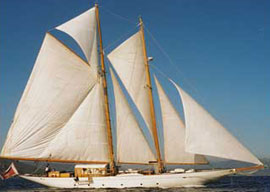
August 09, 2013

Weatherbird
PORTO HELI—I am standing on the deck of a 100-foot schooner that was built in Normandy in 1931 by Gerald and Sara Murphy, the golden American couple who invented the south of France as a summer playground and were in the forefront of artistic and literary Parisian life at the time. More importantly, Ernest Hemingway and Scott Fitzgerald trod on the exact spot where I’m standing—relaxing, rather. I’m surrounded by children and grandchildren but feeling a bit of a midget compared to the types who once sailed on the Weatherbird.
I’ve chartered her for the month of August and the dreaded upcoming birthday, but far more importantly, in order to play Papa Hemingway, who once appeared chez les Murphys with his wife Hadley and his mistress Pauline in tow, as happy a threesome as the Riviera had seen that summer. (Alas, no such luck for the poor little Greek boy.) Gerald Murphy, a very talented painter, had designed a flag for Weatherbird which Picasso, another close friend, admired greatly. It featured a stylized eye in black and white that appeared to wink as it fluttered. Gerald was tall, handsome, and sandy-haired. He wore beautiful cut clothes. Sara was a classical beauty and the couple had three children. They were rich and talented and lived better than anyone, surrounded by beautiful things and gifted artists. Thus the stage was set for the Greek tragedy that followed—the loss of their two boys from disease—and eventual genteel poverty and death. So what else is new? Gerald and Sara were lucky not to live to see the present Cote d’Azur, the sweaty overbuilt hellhole inhabited by crooked Russians and Gulf billionaire camel drivers.
Gerald and Sara were the inspiration for Dick and Nicole Diver in Tender Is the Night, the hauntingly sad novel that broke Fitzgerald’s heart when it was panned by critics but is now considered along with Gatsby as a masterpiece. In one version the novel begins in the south of France, when Rosemary Hoyt spots Dick on the beach and tells her mother, “I fell in love this afternoon.” Neither Gerald nor Sara was best pleased about this, but they said little. They always indulged poor old Scott and understood the hell he was going through with the nutty Zelda as well as his alcoholism and money problems. Cole Porter, another close friend, was among the first to visit in the summer, a deserted time in Cap d’Antibes and the tiny little beach of Garoupe where Gerald had built Villa America. If that wasn’t paradise back then, I don’t know what was.
Just compare today’s parties among the shady people of Monaco and Antibes with those given by the Murphys onboard the Weatherbird: Cole and Linda Porter, Papa and girls, the Fitzgeralds, John Dos Passos, Archibald MacLeish, Dorothy Parker, Picasso, Fernand Léger, Igor Stravinsky, Jean Cocteau (whom Hemingway christened Cocktail), and others of their ilk. Amanda Vaill wrote a brilliant biography of the couple in 1999 called Everybody Was So Young. A much earlier book by Calvin Tomkins was titled Living Well Is the Best Revenge. Both books recalled the enchanting period of the 1920s and early 30s in France and in America, a time that ended with the aftermath of the crash and eventual return to Earth by Gerald and Sara, the death of their sons, and that of Fitzgerald at age 44 in 1940.